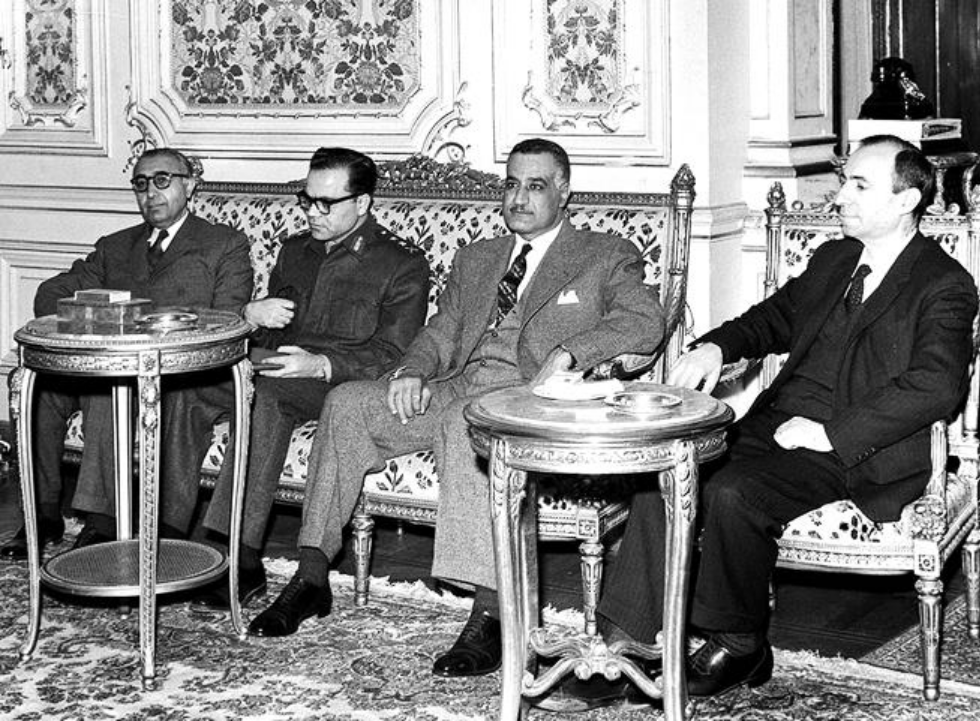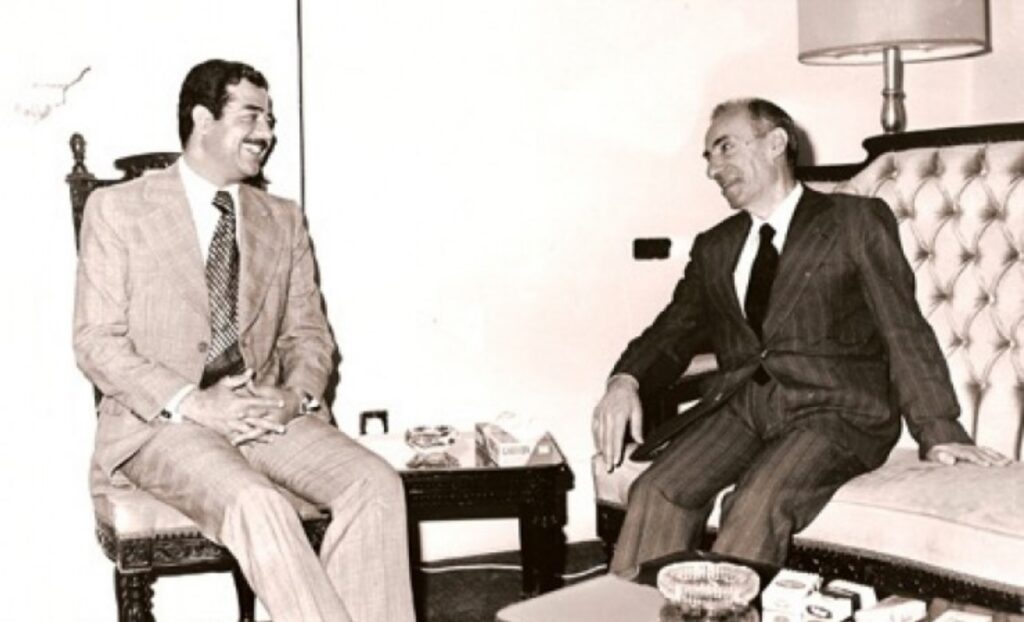When Arab Ba'athism Split
By Liam Nagle / Arab America Contributing Writer
Ba’athism as a political ideology remains a contentious topic for many people and governments. The United States after its 2003 invasion of Iraq, for example, engaged in a policy of “de-Baathification” that removed members of the Ba’ath Party of Iraq from government positions and the armed forces. However, it is worth mentioning that Ba’athism’s controversies aren’t just external, but also internal. This article will cover one such issue within the ideology of Ba’athism – the split between the Iraqi and Syrian Ba’athist parties in the 1960s.
Origins of Ba’athism

Not even the origins of Ba’athism are free of controversy. The Arab Socialist Ba’ath Party – Syria Region recognizes Zaki al-Arsuzi as the main founder and ideologue of Ba’athist thought. He had founded the Arab Ba’ath Party in 1940 in French-occupied Syria, and it espoused a Pan-Arab nationalist and somewhat socialist platform. However, this party was relatively weak – there were not many members, and many of them were concerned more with reading and writing than they were with political action. With this being the case, many prospective members instead joined another party with very similar stances – the Arab Ilhya Movement, or “Arab Revitalization Movement”. This party, founded by Michel Aflaq and Salah al-Din al-Bitar, is instead recognized by the Iraqi branch of the Arab Socialist Ba’ath Party. Unlike al-Arsuzi’s party, it much more successful in gaining members and engaging in political action. Renaming itself into the Arab Ba’ath Movement in 1943, Aflaq and al-Bitar negotiated with al-Arsuzi’s Arab Ba’ath Party to unify into a single force – but notably, al-Arsuzi himself was absent from the discussions. Sources seem to point towards al-Arsuzi’s personal dislike for Michel Aflaq, with the negotiations for unification on his side coming from two other members. In spite of this, the two parties would finally merge in 1947 – first into the Arab Ba’ath Party and, after a merger with the Arab Socialist Party, into the Arab Socialist Ba’ath Party. The predominant leaders of this new party would be Aflaq and al-Bitar, with al-Arsuzi refusing to attend the party’s founding congress and subsequently refusing to engage with it at all.
Origins of the Split

Syria would remain the predominant leader of Ba’athism for around a decade. The Arab Socialist Ba’ath Party would engage in electoral politics in the newly-independent Syria, gaining an enormous amount of traction from amongst the populace. It would become the second-largest party in Syria after the 1954 elections and, now able to leverage its political position, garnered support for Syria’s unification with Egypt – leading to the establishment of the United Arab Republic in 1958. However, under the United Arab Republic’s one-party state, the Arab Socialist Ba’ath Party was officially disbanded, with its members instead recommended to join the newly-formed National Union party. In that same year, a coalition of Ba’athists, communists, and Pan-Arabists under the Iraqi Free Officers Movement initiated a coup d’etat against the Hashemite monarchy in Iraq. They would be successful, killing the king, prince, and prime minister of the country and putting Abd al-Karim Qasim into power. The unification of the UAR and the successful coup in Iraq would be the most significant win for Pan-Arabism in history – they now had leadership roles in both the newly-unified Egypt and Syria, as well as a third country with aspirations for unification with the UAR.
However, this was not to be. When the Ba’ath Party officially disbanded in 1958, the idea was that they would be granted powers within the National Union Party. But this wasn’t the case – Egypt, cautious of sharing power, instead sidelined the Ba’ath Party in government. Although the party was officially disbanded, a smaller number of members continued to clandestinely hold meetings. They did so with the help of a smaller cadre of disgruntled military officials known as the Military Committee – which included, among others, a young officer by the name of Hafez al-Assad. Believing that unification with Egypt was a mistake, the clandestine Ba’ath Party successfully initiated a coup in Syria in 1961, withdrawing the country from the United Arab Republic and instead creating the Second Syrian Republic.
Despite the failures of the UAR, Ba’athism was actually undergoing a new revitalization. In early 1963, a coup led by the Iraqi Ba’ath Party took place against Abd al-Karim Qasim. The Ba’ath Party had hoped to have greater influence in the country following his ascension to power, but were instead sidelined as Qasim instead aligned himself with the Iraqi Communist Party. Given this, the Ba’athists actually ended up cooperating with the US’ Central Intelligence Agency in deposing Qasim, who was given a quick show trial before being executed. In Syria, inspired by this coup, the Ba’athists overthrew the nascent Syrian republic and created the Syrian Arab Republic in 1963. These two acts served as the greatest Ba’athist victory in history – now, Ba’athism was in full control of two states in the Middle East.
The Split

In Syria, the creation of the Military Committee of the Ba’athist Party proved to be the catalyst for the Ba’athist split. Syria’s Ba’athist party itself was split between the civilian leadership, led by Michel Aflaq and Salah al-Din al-Bitar, and the military leadership, led by Salah Jadid and Hafez al-Assad. A power struggle between the two factions ensued, eventually resulting in the 1966 coup – the Military Committee successfully overthrew the civilian leadership, supplanting it as the new leaders of Syria. Aflaq and al-Bitar fled into exile in Lebanon, never again to return to Syria. In their stead, the new Syrian government would promote Zaki al-Arsuzi as the chief ideologue and founder of Ba’athism. Now an older man, he mentored the Military Committee on the ideology of Ba’athism just before his death in 1968.
In Iraq, the pro-Ba’athist ousting of Qasim in 1963 had resulted in various leaders that were mostly pro-Ba’athist, but were not officially part of the party’s leadership. However, the Ba’athist Party in Iraq, led by Ahmed Hassan al-Bakr and a young Saddam Hussein, still had substantial influence. Believing that Aflaq and al-Bitar were the true ideological leaders of Ba’athism, the Iraqi Ba’athists now officially split from the Syrian Ba’athists in 1966. The split between Ba’athism was now complete. Aflaq would be elected as Secretary-General of the Iraqi Ba’athist party in 1966 which, although a largely symbolic position, solidified the divide between Iraq and Syria. Aflaq would remain in Iraq for the rest of his life before dying in 1989.
Conclusion
The Syria-Iraqi Ba’athist split is a very complicated affair. The ideological roots of the split go deep. First, with the creation of two separate Ba’ath parties, pitting Zaki al-Arsuzi against Michel Aflaq and Salah al-Din al-Bitar, which the latter eventually won and became the new rulers of Syria. Aflaq and al-Bitar’s attempts at unifying Syria and Egypt ended in disaster for the party, which resulted in the rise of the military leadership which, after Syria became independent, ousted Aflaq and al-Bitar. Iraq underwent a succession of coups before landing on more pro-Ba’athist leadership. Upon seeing Syria ousting Aflaq and al-Bitar, they split from Syria and endorsed Aflaq. Although Iraq’s Ba’athist government would be overthrown in the 2003 Invasion of Iraq, Syria’s Ba’athist government remains in power in the country – the only country with Ba’athist leadership to this day.
Check out our Blog here!








